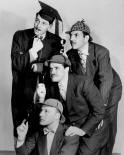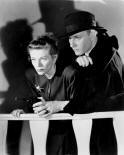|
|
|
|
|
Old Time Radio |
 |
 |
 |
 |
 |
|
|
|
Radio was highly revered in our home. The reason was simple: My father was the majority stockholder and chief engineer of radio station WHDF -- a 250 watt local radio station in Michigan's Copper Country. From the moment we awoke until we went to bed at least one radio was on in our house. As early as I can remember I had an old table model tube radio without a case next to my bed. There was no attempt to shield us from programs that might be too intense. The Shadow, Mysterious Traveler and True Detective Mysteries were my companions along with Nick Carter, Meet Corliss Archer and the Lone Ranger. When I acquired my first tape recorder in 1954 and started recording programs off the air, my father couldn't understand why I would do that. After all, one could hear drama, comedy and quiz shows any day of the week by merely turning on a radio. As far as my father was concerned, network programming had been a staple of radio from the early 30's and would continue to do so as long as there were people and radios. He also believe that TV was a passing fancy and that community cable TV would never amount to anything. In June of 1955 he was in for a rude shock. NBC introduced its new weekend Monitor program. At the same time, it eviscerated its weekday and weeknight programming by eliminating many of the drama and comedy and soap opera programs that had been a staple of listeners for decades. He was unprepared for the loss of programs and struggled to find replacements. In a few more years the remaining commercial networks followed suit. The radio that I had grown up with was gone. At that point I wished that I had seriously undertaken to record network radio programs as I was growing up. Fortunately, many network radio programs were recorded on 16 inch electrical transcriptions. They were not recorded to preserve the programs for posterity but to provide proof to advertisers that their spots had been run. For example, the Fibber McGee and Molly programs were found decades later in the steam tunnels of the Johnson Wax Company in Racine, Wisconsin. Many ET's ended up in the hands of collectors. I began collecting 16 inch ET's in 1958 from my father's radio station. In the decades that have followed I have acquired other ET's from various sources. Gradually I am transferring these and restoring them by removing the pops, clicks and surface noise. In addition, I have written articles relating to old time radio (OTR) for RADIO WORLD magazine and I have included the text of some of these. Just click on the appropriate button to go to an article.
|